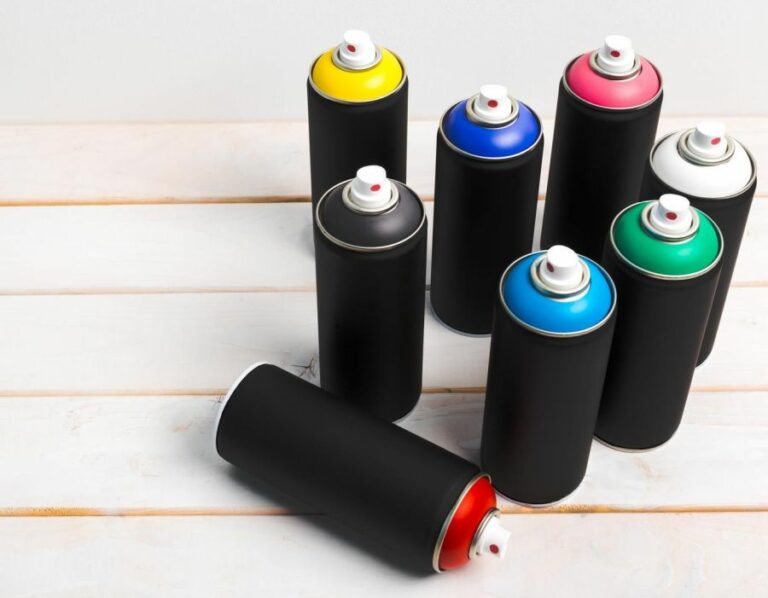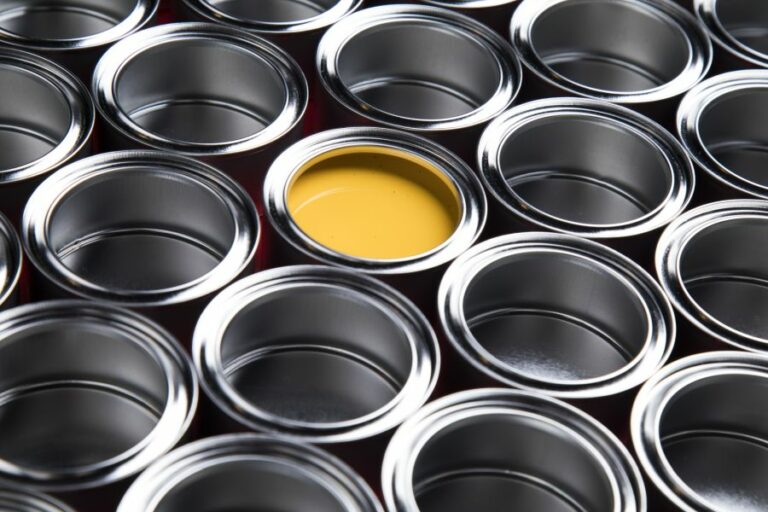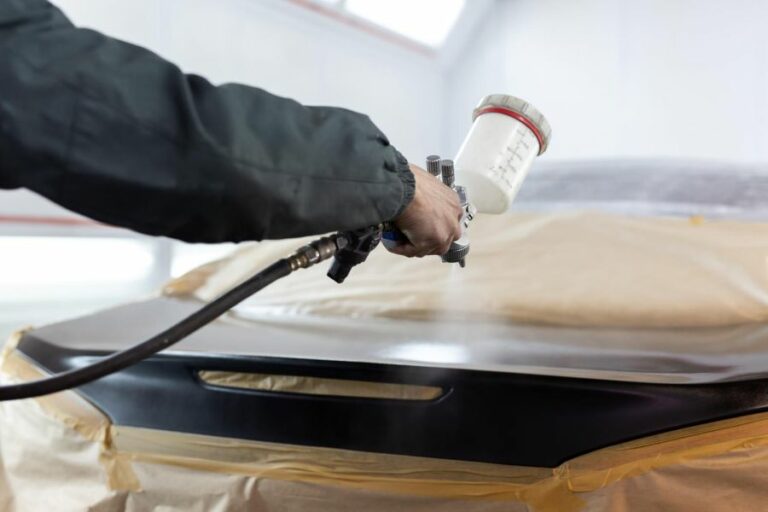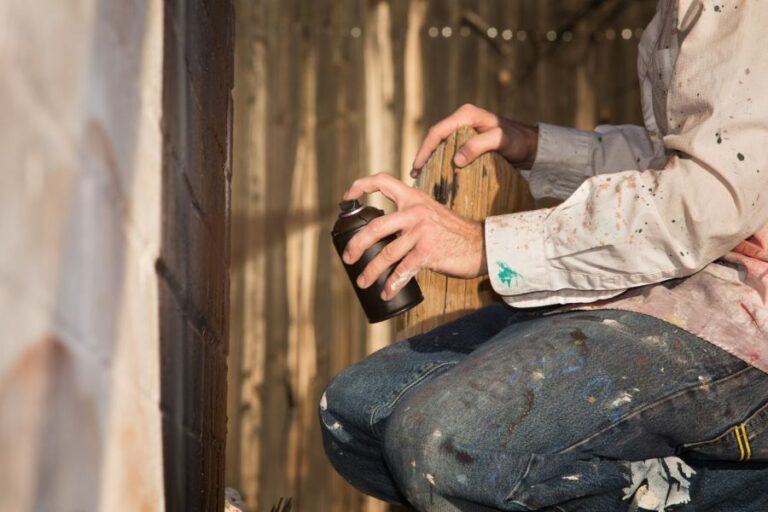Prolonging Spray Paint Can’s Lifespan. What Pros Say
Spray paint cans are a staple in every DIY enthusiast’s arsenal, but they can often run out quickly or lose their effectiveness over time. We have got the perfect solutions to prolong the life of these paint cans and get the most use out of them. With some simple techniques and proper maintenance, you can ensure that your spray paint cans last longer, work better, and save you time and money in the long run.
Prolonging spray paint can’s lifespan:
To prolong the lifespan of spray paint cans, store them in a cool, dry, well-ventilated area in a vertical position; clean the nozzle after every use and inspect the shaker ball regularly; practice proper painting techniques by priming, maintaining proper distance, applying thin coats, and avoiding overheating; and address issues such as leaks, uneven spray, or running out of propellant promptly.

Think your spray paint cans are done for? Think again! We have tips and tricks that will help prolong their lifespan and get more use out of them. Say goodbye to frustration and wasted paint. Keep reading to learn the secrets of keeping your spray paint cans fresh and ready for action!
Contents
- 1 Extending the Durability of Spray Paint Cans
- 2 Enhancing the Longevity of Your Spray Paint
- 3 Shelf Life of a Spray Paint Can: Retention Period
- 4 Effective Spray Paint Preservation Techniques
- 5 Rustoleum Spray Paint Can: Duration of Effectiveness
- 5.0.1 – Introduction: Rust-Oleum’s Reputation for Durability
- 5.0.2 – Shelf Life of a New, Unopened Can
- 5.0.3 – Factors Affecting the Longevity of Rust-Oleum Spray Paint
- 5.0.4 – Proper Storage of Spray Paint Cans
- 5.0.5 – Reviving an Old Can of Rust-Oleum Spray Paint
- 5.0.6 – Conclusion: Proper Storage Extends Rust-Oleum Spray Paint Shelf Life
Extending the Durability of Spray Paint Cans
Spray paint cans are indispensable tools for a wide range of applications, whether for artists, hobbyists, or professionals. However, with regular use, these cans can quickly become empty or, worse, their nozzles clogged or their internal components malfunction.
That is why it’s crucial to take good care of your spray cans to prolong their lifespan, ensuring you get the most out of each can.
• Proper Storage
The first and foremost aspect that affects the life of spray paint cans is how they are stored. Proper storage ensures the paint inside the cans remains in good condition and the cans themselves are protected from damage.
– Climate-Controlled Space
It is essential to store your spray cans in a cool, dry, and well-ventilated area to prevent them from being exposed to extreme temperatures or excessive humidity. (American Coatings Association: Spray Paint FAQs)
These factors can cause the paint to deteriorate, hinder the flow of the propellant, or trigger bursts inside the cans. In addition, always keep them away from direct sunlight, heaters, or AC vents.
– Vertical Position
Place your spray paint cans vertically, with the nozzles facing up. This position helps maintain their internal pressure, which is crucial for the proper functioning of the cans.
• Regular Cleaning
A clean spray paint can is a happy spray paint can. Regular cleaning ensures the paint flows smoothly from the nozzle without clogging. It also helps prevent issues that may arise from built-up residue, such as sputtering or uneven spraying.
– Cleaning the Nozzle
After every use, I recommend immediately wiping the nozzle with a clean, damp cloth to remove any paint residue. Additionally, you can turn the can upside down and give it a few short bursts to clear any excess paint from the nozzle.
If the nozzle is severely clogged, you may need to soak it in a solvent like mineral spirits or acetone for a few minutes to loosen the paint buildup.
– Inspecting the Shaker Ball
Inside most spray paint cans is a mixing ball (or shaker ball), which helps keep the paint properly mixed. From time to time, give the can a good shake and listen for the sound of the ball. If you didn’t hear it moving freely, the paint might have solidified around the ball.
To rectify this issue, try tapping the can gently on a hard surface or shaking it vigorously. If that doesn’t work, you may have to find a way to safely open the can and remove the ball. This should only be done as a last resort, and I recommend consulting a professional before attempting this.
• Using the Right Technique
You’d be surprised how much of a difference the right spray paint technique can make when it comes to prolonging the life of your cans. Here are some tips for painting efficiently and effectively:
– Prime the Can
Before using a spray paint can, especially for the first time, give it a good shake for at least one minute. This helps mix the paint and propellant, ensuring a smooth application.
– Proper Distance
Hold the spray paint can about 8-12 inches away from the surface you’re painting. This distance will ensure even coverage and control overspray, helping you reduce paint waste and make the most of each can.
– Thin, Even Coats
Apply multiple thin coats instead of a single, thick one. This way, the paint will dry faster and more evenly, minimizing the chances of drips, runs, or pooling that can put added strain on the can.
– Avoid Overheating
If you’re using the spray paint can for extended periods, it’s crucial to give it a break every now and then. Continuous use can cause the can to overheat, which can harm the paint, the propellant, and, ultimately, the can’s performance.
• Identifying and Addressing Issues
Even with the best care and maintenance, your spray paint cans might still encounter issues. Here are some common problems and how to address them:
– Can Leaks
Leaks usually occur around the nozzle, especially if it isn’t secured tightly enough. Make sure the nozzle is properly attached, and wipe away any paint residue to prevent future leaks.
Small leaks around the can’s body can often be resolved by applying a small amount of epoxy or silicone sealant to the affected area.
– Uneven Spray
If the paint is coming out unevenly or sputtering, it could be due to a clogged nozzle (as mentioned above) or an issue with the propellant.
If neither cleaning the nozzle nor vigorously shaking the can resolves the issue, it might be wise to consult a professional or dispose of the can responsibly.
– Running Out of Propellant
If you’ve used a can extensively, you may find that you still have paint left in the can, but the propellant has run out. This usually means it’s time to dispose of the can and pick up a new one.
However, some specialty retailers and art supply stores offer can refill services. It’s worth checking with your local shops to see if this option is available. (University of Oregon: Spray Paint Safety Tips)
• Conclusion
Prolonging the lifespan of your spray paint cans is not only a matter of proper care and cleaning; it also involves using the right techniques when painting and being prepared to address potential issues.
By following the tips and recommendations in this article, you can ensure you get the most out of each can, save money on replacements, and create better results in your painting projects.
Enhancing the Longevity of Your Spray Paint
As an experienced user of various spray paint brands and types, I know how important it is to get the most out of each can.
Extending the life of your spray paint is not only cost-effective but also ensures your projects have a professional and long-lasting finish. This comprehensive guide will help you make your spray paint last longer.
• Choose the Right Quality Spray Paint
Opting for high-quality spray paint is a wise decision. The paint pigments of premium brands tend to be more durable, ensuring that they last longer on surfaces.
Moreover, they usually deliver better coverage and dry quicker, reducing the overall number of coats needed. Investing in a renowned spray paint brand may cost more upfront, but the longevity it provides is worth the extra expense.
• Proper Surface Preparation
Performing proper surface preparation is crucial to ensuring that the paint adheres correctly and lasts longer. Start by cleaning the surface thoroughly to remove dust, grime, or grease, which may affect the adhesion of the paint.
If the surface is rusty or has old paint, consider sanding or using a wire brush to remove any loose material.
Additionally, using a primer before painting can improve paint adhesion and durability. A primer creates a solid base for the spray paint, ensuring that it adheres better to the surface, enhancing the longevity of the paint job.
• Correct Gun Attachment and Pressure
When using a spray gun for your projects, attaching the can correctly and maintaining appropriate pressure is vital. If the can is not connected properly, leakage may occur around the nozzle, leading to wasted paint.
Moreover, using too much pressure can cause over-spraying, while too little pressure may result in uneven coverage.
Follow the manufacturer’s instructions for connecting the can to the spray gun and maintain the recommended pressure. Experimenting with the pressure settings may help you determine the optimal level for an efficient and prolonged paint job.
• Optimize Your Painting Technique
Using a consistent painting technique can save paint while achieving better coverage. Start by shaking the can well before use and do a test spray on a scrap piece of material to assess the nozzle performance and spray pattern.
Hold the can 8-12 inches from the surface and apply the paint in thin, even coats using a side-to-side motion.
Overlap each pass by about 50% to avoid leaving any gaps in coverage. Be careful not to linger in one place for too long, as this can cause the paint to accumulate and create drips, which may require more paint to even out.
• Store Spray Paint Properly
Storing your spray paint cans correctly is essential to maintain their shelf life and prevent any deterioration in the paint quality. Keep your spray paint cans in a cool, dark place away from heat sources and direct sunlight. Extreme temperatures can degrade the paint and reduce its lifespan.
Additionally, store the cans with the nozzles facing up to prevent clogging. In case the nozzle does become clogged, cleaning it with warm water or replacing it with a new one can help prolong the paint’s lifespan.
• Use a Spray Paint Extender
A spray paint extender is an additive that can be mixed with the paint to improve its workability and open time (the period during which the paint can be reworked).
Extenders, like Flood Floetrol, slow down the drying time, allowing the paint to level out and reduce brush marks, resulting in a more professional finish. This increased workability means you can cover more area with less paint, extending the life of your paint.
• In Conclusion
To make your spray paint last longer, choose high-quality paint, prepare the surface well, use a consistent painting technique, and practice proper storage.
Additionally, using a spray gun at the correct pressure, applying a primer beforehand, and utilizing a paint extender can ensure optimal results.
Following these tips will help you make the most of your spray paint and achieve a durable, long-lasting finish on your projects.
Step | Description |
|---|---|
1 | Prep and clean the surface before applying spray paint to remove any dirt, grease, or dust that may hinder paint adhesion. |
2 | Shake the spray paint can well before using to ensure proper mixing of paint components and even flow during application. |
3 | Apply multiple thin coats of spray paint instead of a single thick coat, allowing each coat to dry fully before applying the next one. Thin coats will last longer and prevent paint cracking or flaking. |
4 | Use a high-quality spray paint that offers added protection, such as UV resistance or rust inhibitors, to extend the life of the paint. |
5 | Apply a clear coat or sealer over the spray paint to help protect it from damage and extend its life. |
6 | Store spray paint cans properly when not in use. Keep them in a cool, dry place and away from direct sunlight or extreme temperatures. |
Shelf Life of a Spray Paint Can: Retention Period
Whether you’re an artist or a DIY enthusiast, using spray paint can be an efficient and effective way to transform objects, surroundings, and bring life to projects. One common question often raised is regarding the lifespan of these spray cans.
• Shelf Life of Spray Paint
Spray paint typically remains effective and usable for 2-3 years if properly stored. However, it is essential to note that many factors can influence the longevity of your paint, like storage conditions, quality, and environmental conditions.
As a result, it is difficult to guarantee a precise timeframe for when a spray paint can will no longer function as intended.
– Storage Conditions
Proper storage can significantly impact the lifespan of spray paint cans. The environment they are stored in should be dry, cool, and away from direct sunlight.
Ideally, the storage temperature should range between 60-80°F (15-27°C). Moreover, it is crucial to store the cans in an upright position to avoid leakage and paint settling.
– Quality of Spray Paint
Higher-quality spray paint may likely have a longer shelf life compared to cheaper, lower-quality alternatives. While cost should not be the only determiner of paint quality, investing in reputable brands like Rust-Oleum and Krylon is recommended to ensure the longevity of the paint in the can.
– Environmental Conditions
As previously mentioned, temperature and humidity can have a significant impact on the shelf life of spray paint. If you live in an area with fluctuating temperatures, it may be best to store your cans indoors to avoid potential changes in the paint’s quality.
• Signs of Expired Spray Paint
While it is crucial to be aware of the recommended shelf life, there are certain signs that your spray paint has gone bad. These include:
– Poor Spray Performance
One sign that your spray paint may have expired is if the can struggles to produce a consistent, even spray. Be sure to check if the spray nozzle is clogged before concluding that the paint itself has expired. Cleaning the nozzle may rejuvenate the spray’s performance.
– Separated or Clumpy Paint
When the pigments and solvents in the paint begin to separate, the can may no longer function properly. If the paint appears to be separated, clumpy, or not mixing well, even after thorough shaking, it may be time to dispose of it properly.
– Unpleasant Odor
Before using any expired spray paint, it is wise to test it on scrap material first. If you notice a strong, unpleasant odor during your test spray, it could be an indication that the paint has spoiled.
• Tips to Extend the Lifespan of Spray Paint Cans
To make the most out of your spray paint, consider following these tips to help extend the life of the cans:
– Properly Seal the Cap
Always ensure that the cap is securely fastened after each use. This will help prevent the paint from drying out, maintain pressure within the can, and protect the nozzle from contaminants.
– Keep the Nozzle Clean
Cleaning the nozzle after each use helps to prevent clogging and maintains the spray’s performance. One method to clean the nozzle is by turning the can upside down and spraying until only clear gas comes out. This clears any remaining paint residue within the nozzle.
– Proper Storage
As previously mentioned, storage plays a crucial role in extending the life of spray paint cans. Following the appropriate storage guidelines will help prevent any damage or spoilage to the paint.
• Disposing of Expired Spray Paint Cans
Lastly, once you’ve determined that your spray paint has expired or lost its effectiveness, proper disposal is essential. Many local waste disposal and recycling centers offer services for hazardous materials, such as spray paint cans.
Be sure to consult your local waste management to inquire about proper procedures and guidelines for disposing of your spray paint cans.
In conclusion, while spray paint cans may have a general shelf life of 2-3 years, environmental factors, storage conditions, and overall quality may play a role in determining their actual longevity.
Following these storage and maintenance tips can help ensure that your spray paint cans remain in good condition until you need them for your next project.
Storage Condition | Duration |
|---|---|
Unopened, cool & dry place | 2-3 years |
Opened, cool & dry place | 1 year |
Unopened, temperature fluctuations & humidity | 1-2 years |
Opened, temperature fluctuations & humidity | 6 months – 1 year |
Effective Spray Paint Preservation Techniques
Spray paint is a versatile and popular medium used by artists, hobbyists, and professionals for various applications, from graffiti and street art to DIY projects and home renovations.
Although spray paint is renowned for its rapid drying time, durability, and vibrant colors, preserving the final product is still essential to enhance its lifespan and protect it from environmental factors or potential damage.
• The Importance of Surface Preparation
The initial stage in preserving spray paint is to ensure that the surface you are painting on is properly prepped. For optimal adhesion and longevity, it is essential to clean, sand, and prime the surface beforehand.
– Cleaning the Surface
To achieve the best results, remove any dirt, grease, or loose particles from the surface before applying any paint. This not only ensures a smooth finish but also allows the spray paint to bond better with the surface, increasing its durability.
Use a soft cloth or sponge with mild detergent and water to clean the surface gently.
– Sanding and Smoothing
Once the surface is free from grime, it is crucial to sand it to create a smooth, even texture. This helps by creating a better bonding surface for the primer and spray paint.
Use sandpaper or sanding blocks with medium to fine grit, depending on the surface. After sanding, be sure to remove any dust or debris left behind.
– Applying Primer
Primer is an essential step in preparing the surface, as it promotes adhesion, minimizes the material’s porous nature, and provides added durability. It is recommended to use a spray primer specifically designed for this purpose for spray paint.
Check the label for compatibility with the surface and spray paint type, as some products cater to specific materials such as metal, plastic, or wood.
• Selecting the Right Type of Spray Paint
There is a vast array of spray paint options available in the market, but the key to ensuring the longevity of your work is to invest in high-quality, UV-resistant, and weatherproof spray paint.
Look for products that have these properties, as they can contribute significantly to preserving the work and preventing fading due to sunlight or harsh weather conditions.
• Proper Application and Curing of Spray Paint
One of the most common mistakes when using spray paint is not applying the paint correctly or allowing sufficient curing time. Here are some useful tips to ensure effective application and curing process:
– Ensure Adequate Ventilation
Spray painting in a well-ventilated area is crucial for your safety and the artwork’s longevity. Adequate airflow promotes the paint’s drying process and helps prevent paint buildup, which can cause peeling or cracking over time.
– Spray Painting Technique
Maintain a consistent distance of around 10-16 inches from the surface while holding the can at a slight angle. Apply the paint in thin coats, using smooth, horizontal, or vertical strokes, and allow each layer to dry before applying the next one.
This reduces the risk of running, dripping, or paint buildup that can compromise the artwork’s longevity.
– Allow Enough Curing Time
Although spray paint dries relatively quickly, it is essential to allow ample curing time before handling or exposing the object to the elements.
Follow the manufacturer’s instructions regarding curing time, which typically ranges from 24 to 48 hours. This ensures proper hardening and contributes to the durability of the paint.
• Protecting the Finished Artwork with Clear Coats
Applying a clear coat over the spray paint efficiently shields the artwork from environmental factors such as sunlight, moisture, and dirt. Various options are available, from matte to glossy finishes. Keep in mind to select a clear coat that is compatible with the spray paint used.
– What to Consider When Applying Clear Coat
- Ensure the spray paint is completely dry before applying the clear coat.
- Apply multiple thin coats while allowing each layer to dry before applying the next one.
- Hold the can at a consistent distance from the surface, around 10-16 inches.
- Allow the clear coat to cure to ensure maximum protection.
• Routine Maintenance and Cleaning
Taking care of the artwork regularly can significantly contribute to preserving its lifespan. For outdoor spray-painted pieces, periodic cleaning using a soft brush or cloth can remove dirt and debris accumulated on the surface.
Avoid using harsh chemicals or abrasive materials that could damage the paint.
• Conclusion
Preserving spray paint is a combination of diligent surface preparation, selecting high-quality materials, proper application and curing of paint, and protective measures such as clear coating and maintenance.
By following these tips and techniques, you can successfully protect and extend the lifespan of your spray paint projects. Remember, patience and attention to detail are ultimately the key factors in achieving long-lasting and resilient artworks.
Step | Instruction |
|---|---|
1 | Choose a suitable location for spray painting, ensuring it’s well-ventilated, away from direct sunlight, and protected from wind and dust. |
2 | Prepare the surface of your workpiece by cleaning it, removing any dust or dirt, and sanding it if necessary. |
3 | Apply a primer coat before spraying paint onto the surface. This will help the paint adhere better and increase its durability. |
4 | Shake the spray paint can well before use and apply the paint using even, smooth strokes. Apply several thin coats instead of one thick coat for better coverage and to prevent drips or runny paint. |
5 | Allow the spray paint to dry completely, preferably for at least 24 hours or according to the manufacturer’s instructions. |
6 | Apply a clear coat or sealant over the dried paint to help protect it from ultraviolet light, scratches, and other potential damages. This will also provide a glossy finish to your workpiece (if desired). |
7 | Store the spray paint cans properly by keeping them in a cool, dry place and away from sources of heat or flames. |
Rustoleum Spray Paint Can: Duration of Effectiveness
– Introduction: Rust-Oleum’s Reputation for Durability
Rust-Oleum is well-known in the paint industry for its high-quality, durable products. They pride themselves on providing long-lasting solutions for a variety of surfaces.
One of the most popular products is their spray paint line, which offers convenience and exceptional coverage. But how long does Rust-Oleum spray paint last in the can?
– Shelf Life of a New, Unopened Can
Rust-Oleum spray paint has a shelf life of approximately two to four years from the production date if the can is unopened and properly stored.
On their FAQ page, Rust-Oleum mentions that their products have a “best used by” date printed on the label, guiding users to ensure the best results.
Generally, if the can remains sealed and is kept at a moderate temperature away from moisture, its performance and properties should remain intact during this period.
– Factors Affecting the Longevity of Rust-Oleum Spray Paint
Exposure to Extreme Temperature
Extreme temperatures, either hot or cold, can compromise the integrity of the spray paint, affecting its lifespan. Ideally, store the cans at temperatures between 50 and 90 degrees Fahrenheit.
Exposure to temperatures outside this range can cause the paint to thicken, making it difficult or impossible to spray.
Humidity and Moisture
Moisture, especially when combined with temperature fluctuations, can lead to can rusting and paint degradation. Also, cans stored in moist conditions might experience clogs in the nozzle. To prevent humidity-related issues, store the cans in a dry, well-ventilated area.
Partially Used Cans
Once a Rust-Oleum spray paint can is opened and partially used, its shelf life might diminish. Exposure to air may cause the paint to deteriorate or thicken over time. Therefore, it is essential to thoroughly clean the nozzle and properly seal the can after every use.
– Proper Storage of Spray Paint Cans
To maximize the longevity of Rust-Oleum spray paint, follow these storage recommendations:
- Store cans vertically, with the nozzle facing up. This positioning prevents clogging and ensures the paint remains at optimal consistency.
- Choose a well-ventilated and dry storage location, away from moisture or dampness, which can lead to rusting.
- Maintain a temperature range of 50 to 90 degrees Fahrenheit to preserve the paint’s quality and consistency.
- Avoid direct sunlight, as it may raise the temperature and cause pressure to build up inside the can.
- Keep away from open flames and other sources of heat that could compromise the integrity of the can, posing a risk of explosion.
– Reviving an Old Can of Rust-Oleum Spray Paint
If you find an old can of Rust-Oleum spray paint, here are some tips to rejuvenate it and make it usable:
- Inspect the can for signs of rust, leakage, or damage. If the integrity of the can is compromised, it may be best to dispose of it properly.
- Test the spray nozzle by depressing it several times. If the nozzle is clogged, it may be necessary to soak it in mineral spirits or replace it with a new one.
- Gently shake the can for at least one minute to ensure the paint is well-mixed and any settled pigments are redistributed.
- Perform a test spray onto a piece of cardboard or other disposable surfaces to evaluate if the paint is still viable and sprays evenly.
– Conclusion: Proper Storage Extends Rust-Oleum Spray Paint Shelf Life
In conclusion, Rust-Oleum spray paint has a respectable shelf life of two to four years, provided proper storage techniques are applied.
Factors such as extreme temperatures and humidity can negatively impact the paint’s longevity, so it is essential to be mindful of storage conditions. Should you discover an old can of spray paint, follow the revival tips mentioned above and safely test the paint to ensure it is still usable.
By properly caring for Rust-Oleum spray paint cans, you can ensure a long-lasting painting solution for your projects.







